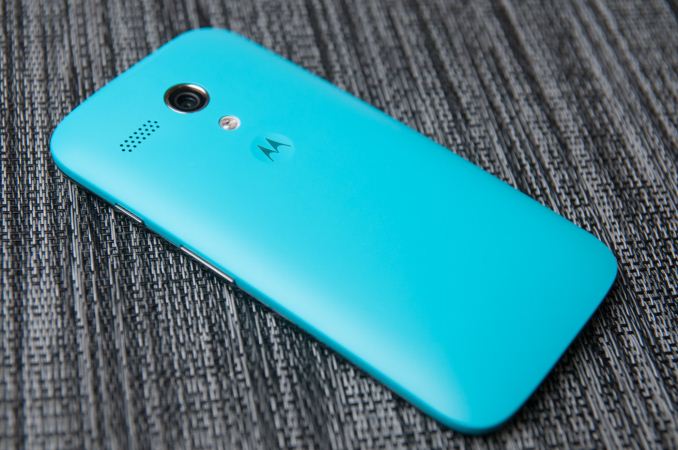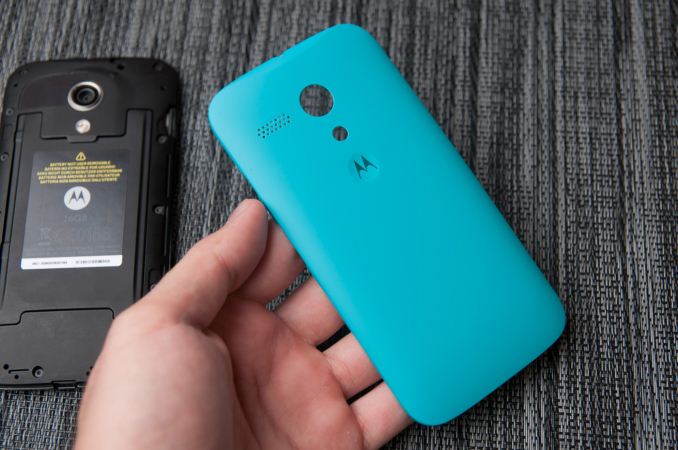Motorola Moto G Review
by Brian Klug on December 18, 2013 2:00 PM EST- Posted in
- Smartphones
- Motorola
- Mobile
- *VA
- Cortex A7
- snapdragon 400
- Moto G
Making an affordable smartphone for the masses that aren’t willing to spend the dime on flagship-tier devices is a pitch I’ve heard a few times. Usually the device starts out great, but software support ends up being negligible from the start, or the device has serious caveats in actual practice. The number of mid to low end phones I’ve seen which promised to be halo devices of the mass market but are stuck running the same software they launched with could fill a few desk drawers.
I’ve been using Moto G as my daily driver since getting it, and absent a few features (camera, LTE, always on voice and display tuning), the device is surprisingly close to offering a similar kind of experience as the Moto X. Form factor is roughly equivalent, it’s like a Moto X that has put on a few pounds and a few millimeters around the edges. The physical differences aren't huge, and I'm glad that Motorola didn't sacrifice anything major by adding removable back shells.
On the display side I'd actually opt for an LCD over AMOLED to begin with for power reasons, although with emphasis on calibration. Resolution and contrast is excellent on the Moto G. I miss the camera activation flick gesture from the Moto X, and to a lesser extent the always on voice activation, but trading those off in favor of a lower price point makes a lot of sense given their reliance on extra dedicated silicon and more expensive display.
The previous generation of Snapdragon 400-based phones that I played with for some reason never really was fast enough to smooth over the demanding parts of Android 4.x. The four Cortex A7s and Adreno 305 in MSM8x26 seem competent enough to run Android at a decent clip without hesitation or dropped frames. I’d wager Motorola’s continued use of F2FS which started with the Moto X also helps the system feel speedy and storage I/O competitive. The storage sizes available are comparatively small at 8 and 16 GB, and given the small price delta between the two there's really no reason anyone should opt for the smaller of the two. I'm eager to see how much the Android 4.4 KitKat update improves memory occupancy on the Moto G, since occasional app suspension is my only usability complaint on Moto G.
The Moto G grew on me considerably in the time I've spent with it, just like Moto X did before it. The question is ultimately whether the Moto G delivers a good overall experience for the price – I'd argue it definitely does.












120 Comments
View All Comments
bhima - Monday, December 23, 2013 - link
The market are people that, for example, pay only $25 a month each on a T-mo family plan and they don't want to drop an extra $30 a month for 2 years for a phone, Or sign up for a contract with ATT/Verizon and blow easily $60+ a month. 500mb of data at HSPA+ speed (9mbps in my area) with no overage charge, unlimited talk and text for $25 a month makes this phone a huge winner to those willing to look for a good experience without burning a hole in your wallet.teiglin - Wednesday, December 18, 2013 - link
Every time I read reviews of this I'm surprised at how closely MSM8x26 performs to flagships from as recently as last year. Obviously it isn't really in the running compared to 8974, Apple A7, Exynos 5250, etc., much less APQ8064, so I think this says more embarassing things about companies that shipped quad-A9 flagships in mid-to-late-2012, but still, the end result is that the display and silicon leads to an experience comparable to (if not better than) a GS3 i9300. This is pretty surreal at the sub-$200 price point, while a new i9300 still goes for ~$400. Of course there are other sacrifices and if we're talking about $400 life begins and ends with the Nexus 5, but still, Motorola has really accomplished something with the Moto G. This is the phone I'd buy for my son if he were five years older; hopefully by the time he's old enough to have his own smartphone, Motorola will be still have something comparable on sale so he can get a quality device at this price point.teiglin - Wednesday, December 18, 2013 - link
Exynos 5420. Not really sure where 5250 came from, but... thingssayash - Thursday, December 19, 2013 - link
5250 is now more than a year old, it was the soc in the nexus 10, so yeah.Bobs_Your_Uncle - Thursday, December 19, 2013 - link
By the way, how's that Nokia 1020 review coming?Klug4Pres - Thursday, December 19, 2013 - link
Brian, I am curious about the impact of operating system version on the benchmark comparisons. Presumably the results in your tables are based on whatever version was installed at the time of initial testing, which is perfectly reasonable.However, it would be interesting to gauge the impact of, for example, new Android versions on a device's scores. Is there an appreciable change in performance going from, say, 4.2 to 4.3 or 4.4 on Nexus 4?
I realise it would be a lot of work to try to update all benchmarks on every software release across every OEM, and anyway you do not necessarily retain access to most of the devices you test, but this might be feasible on just the Nexus devices, which I have a feeling you tend to keep around. On the other hand, maybe the results aren't really very interesting.
Qwertilot - Thursday, December 19, 2013 - link
Fascinating to see what happens with and its relatives/competition in next few years.In a sane world this sort of thing would take huge chunks of the market for high end phones. The current market with the very expensive ultra high end models selling so much at such premiums surely can't be sustainable long term.
Only thing is that I'm not sure how rational this market is :)
uhuznaa - Thursday, December 19, 2013 - link
With smartphones and tablets becoming a mass-market it will be as rational as any other market. Like clothing, shoes or food. Which means not very rational, there will be room for huge price spans and very different products, some of them rational and others not at all. This is hard to digest for geeks, I know.Qwertilot - Thursday, December 19, 2013 - link
True. The special thing for the mobile market is the rather big locked in distortions via contracts/subsidies etc.Certainly nice to have this sort of option around.
ESC2000 - Monday, December 23, 2013 - link
problem is that the average person thinks s/he needs the newest shiniest most powerful device that she will probably never take advantage of, and the up front subsidy (but pay out the rear) system facilitates the impulse to purchase an overly powerful device in the US by making Americans less price sensitive. It is really annoying to listen to people who think a small very powerful computer that pushes more pixels than their laptop only costs - and should only cost - $200 at most.